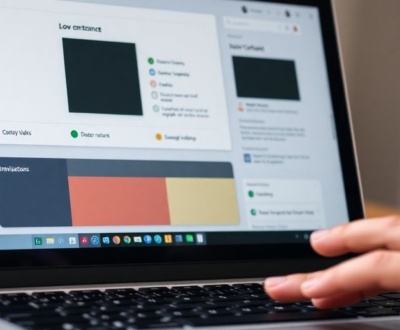So, you’re building a website, right? And you want it to be super fast and smooth for everyone who visits. That’s where something called ‘lazy loading’ comes in. It’s a pretty neat trick that can make your site feel way snappier, especially on phones or slow internet. But, like anything, there are some things to watch out for. We’re going to talk about how lazy loading works, why it’s good for users, and how to use it without causing any headaches. It’s all about making your website a better place to hang out, without making people wait around.
Key Takeaways
- Lazy loading helps pages load quicker by only showing content when it’s actually needed, which is great for user experience.
- Using lazy loading can make your site feel more responsive and keep people on your page longer.
- It’s really good for mobile users because it saves data and battery life.
- You need to be careful with lazy loading so it doesn’t mess up how search engines see your site or make things look weird for users.
- The future of lazy loading might involve smart tech that predicts what you’ll want to see next, making things even faster.
The Impact of Lazy Loading on User Experience

Lazy loading can really change how people experience your website. Instead of loading everything at once, it waits to load images and other media until they’re actually needed. This can make a big difference in how fast your site feels and how engaged people stay.
Improved Page Load Time
The most noticeable impact of lazy loading is faster initial page load times. Page speed is super important. When a user first visits your site, they don’t have to wait for every single image to load before they can start interacting with the page. This makes the site feel much more responsive and less clunky. Think about it: nobody wants to stare at a blank screen while a bunch of stuff loads in the background.
Enhanced User Engagement
Faster loading times directly translate to better user engagement. If a site loads quickly, people are more likely to stick around and explore. Slower sites? People bounce. Lazy loading helps keep users on your site longer, which can lead to more conversions, more page views, and overall, a better experience. It’s all about keeping people interested and not giving them a reason to leave. A faster site makes people happy, and happy people are more likely to engage with your content.
Better Resource Management
Lazy loading is also great for managing resources, especially on mobile devices. Mobile users often have limited bandwidth and battery life. By only loading images and videos as they scroll, you’re saving them data and battery. This is a huge win for user experience, especially for people who are browsing on the go. It’s about being considerate of their resources and making sure your site doesn’t drain their battery or eat up all their data. Plus, it reduces the load on your servers, which can save you money in the long run. Using web development techniques like lazy loading is a win-win for everyone.
Strategies for Implementing Lazy Loading in Web Design
Lazy loading can really help speed up your website, but you’ve got to do it right. It’s not just about slapping it on everything and hoping for the best. It’s about thinking strategically about what content really needs to load right away and what can wait until the user scrolls down.
Prioritizing Content Visibility
The key is to load what’s visible first. Think about what the user sees when they first land on the page. That stuff needs to be there, pronto. Everything else? Let it chill until it’s needed. This approach makes the initial experience much faster and smoother. It’s all about giving the user something to look at immediately, so they don’t bounce.
Using the Intersection Observer API
The Intersection Observer API is a game-changer. It lets you easily detect when an element comes into view. No more clunky scroll event listeners! It’s way more efficient and makes implementing lazy loading a breeze. You can set it up to trigger the loading of an image or video as soon as it enters the viewport. It’s pretty cool how well it works.
Balancing Content Availability
Don’t go overboard with lazy loading. If users have to wait too long for content to appear, they’ll get frustrated. It’s a balancing act. You want to improve performance, but not at the expense of the user experience. Make sure there’s some indication that content is loading, like a placeholder or spinner. And definitely don’t lazy load anything above the fold! That’s just asking for trouble.
Lazy loading is a powerful tool, but it’s not a magic bullet. It requires careful planning and consideration. Think about your users, your content, and your website’s goals. When done right, it can make a huge difference in performance and user satisfaction. But when done wrong, it can be a disaster.
Lazy Loading: Enhancing Mobile User Experience
Mobile users demand speed. They’re often on the go, with limited data plans and varying network conditions. That’s why lazy loading is so important for mobile. It can make a huge difference in how people experience your site.
Reduction in Initial Page Load Time
Lazy loading drastically cuts down on initial page load time on mobile devices. Instead of loading everything at once, you only load what’s immediately visible. This means faster initial rendering and a quicker time to interactive, which is crucial for keeping users engaged. Think about it: nobody wants to wait forever for a page to load, especially on their phone.
Improved Resource Management on Mobile
Mobile devices have limited resources. Bandwidth, processing power, and battery life are all precious. Lazy loading helps conserve these resources by only loading images, videos, and other assets when they’re actually needed. This not only speeds up the browsing experience but also helps extend battery life, which is a win-win for users. It’s about being efficient and considerate of the user’s device capabilities. lazy loading is a great way to do this.
Enhanced User Engagement on Mobile
A faster, more responsive site leads to higher user engagement. When pages load quickly and interactions are smooth, users are more likely to stick around and explore your content. Lazy loading contributes to this by reducing bounce rates and encouraging users to delve deeper into your site. It’s all about creating a positive and seamless experience that keeps users coming back for more.
Lazy loading isn’t just about speed; it’s about respect for the user’s time and resources. By optimizing the mobile experience, you’re showing that you value their engagement and are committed to providing a smooth and enjoyable browsing experience.
Here’s a simple comparison of load times:
| Scenario | Initial Load Time (Without Lazy Loading) | Initial Load Time (With Lazy Loading) |
|---|---|---|
| Image-Heavy Page | 6 seconds | 2.5 seconds |
| Video-Rich Page | 8 seconds | 3 seconds |
Here are some benefits of lazy loading:
- Faster initial load times
- Reduced data usage
- Improved battery life
- Better user engagement
Best Practices for Lazy Loading Images and Videos
Optimizing your website’s performance is super important for making users happy and getting better search engine rankings. One way to do this is by using lazy loading for images and videos. This means the media files only load when they’re needed, which can really speed up the initial page load. But, to get the most out of it, you gotta follow some best practices.
Setting Appropriate Placeholders
When you’re lazy loading, you don’t want users to just see a blank space while they wait for the image or video to load. That’s where placeholders come in. A good placeholder gives the user a visual cue that something is coming, so they don’t think the page is broken. You can use a solid color, a blurred version of the image, or even a simple icon. The key is to make it clear that content is on its way.
Using Low-Quality Image Placeholders
Low-Quality Image Placeholders (LQIPs) are a great way to improve the perceived loading speed. Instead of a blank space, you show a very small, highly compressed version of the image. This loads almost instantly and gives the user a preview of what’s to come. Once the full-resolution image is ready, it smoothly replaces the LQIP. It’s all about making the wait feel shorter.
Ensuring Content Accessibility
Lazy loading shouldn’t make your site less accessible. Make sure that even if JavaScript is disabled or the image fails to load, users can still understand the content. Use the <noscript> tag to provide alternative content for users without JavaScript. Also, always include alt attributes for your images, describing what the image is about. This is important for screen readers and SEO.
Lazy loading is a great tool, but it’s not a magic bullet. You need to think about how it affects the user experience and make sure it’s implemented in a way that’s both performant and accessible. Don’t just blindly add it to every image and video on your site. Plan it out, test it, and make sure it’s actually making things better.
Here’s a quick checklist to keep in mind:
- Always use placeholders.
- Consider LQIPs for a better perceived loading experience.
- Ensure accessibility with
altattributes and<noscript>tags. - Test your implementation on different devices and browsers.
- Monitor your site’s performance to see if lazy loading is actually helping.
Measuring the Performance Benefits of Lazy Loading
It’s important to know if lazy loading is actually helping your site. You don’t want to implement something that makes things worse, right? So, how do we check?
Analyzing Initial Load Time Reduction
The most obvious benefit of lazy loading is a faster initial load time. Before you implement lazy loading, record your site’s initial load time using tools like Google’s PageSpeed Insights or WebPageTest. After implementation, run the tests again. You should see a noticeable decrease. This is usually the first thing people look at.
Tracking Bounce Rate Decreases
If your site loads faster, people are more likely to stick around. A high bounce rate means people are leaving your site quickly, often because it takes too long to load. Implement lazy loading, then monitor your bounce rate in Google Analytics. A lower bounce rate suggests that lazy loading is improving user engagement. It’s not a perfect metric, but it’s a good indicator.
Monitoring Time to Interactive
Time to Interactive (TTI) is how long it takes for a page to become fully interactive – when users can actually click buttons and fill out forms. Lazy loading should reduce TTI by deferring the loading of non-essential resources. Again, use performance testing tools to measure TTI before and after implementation. A lower TTI means a better user experience. It’s all about making the site usable as quickly as possible.
It’s important to remember that performance metrics can fluctuate based on network conditions and user devices. Run multiple tests and analyze trends over time to get a clear picture of lazy loading’s impact. Don’t just rely on a single data point.
Common Pitfalls and Challenges in Lazy Loading
While lazy loading can really help speed things up, it’s not always smooth sailing. There are some potential problems you should know about before diving in. It’s not a magic bullet, and if you’re not careful, you could end up making things worse.
Negative SEO Implications
One of the biggest worries with lazy loading is how it can mess with your search engine optimization. If search engines can’t easily crawl and index your content, your rankings could take a hit. Search engine bots aren’t always great at handling content that loads asynchronously. Make sure you’re using proper techniques to ensure they can still see everything. For example, you might want to use server-side rendering or make sure your content is accessible even without JavaScript. It’s a bit of extra work, but it’s worth it to avoid hurting your SEO.
Perception of Slower Page Loading
Even though lazy loading is supposed to make things faster, it can sometimes feel slower to users. If content pops in unexpectedly as they scroll, it can be jarring and make the page feel disjointed. The key is to provide clear visual cues, like placeholders or loading spinners, so users know something is coming. This helps manage their expectations and prevents them from thinking the page is broken. It’s all about creating a smooth and predictable experience.
Excessive Network Requests
If you’re not careful, lazy loading can actually lead to more network requests, not fewer. This can happen if you have a ton of images or other assets that all load as the user scrolls. It’s important to throttle the loading and prioritize what’s most important. Think about using techniques like request coalescing or only loading content that’s within a certain distance of the viewport. UI design errors can be avoided by testing and optimizing your implementation to minimize the number of requests.
Lazy loading isn’t a set-it-and-forget-it kind of thing. You need to constantly monitor its performance and make adjustments as needed. Use tools like Google Lighthouse to track your page speed and identify any bottlenecks. Pay attention to user feedback and be willing to tweak your implementation to get the best results.
Here’s a quick table summarizing some common issues:
| Issue | Solution |
|---|---|
| SEO problems | Use server-side rendering, ensure content is accessible without JavaScript |
| Perceived slowness | Use placeholders, loading spinners |
| Excessive network requests | Throttle loading, prioritize content |
- Make sure to test on different devices and browsers.
- Monitor your page speed regularly.
- Don’t be afraid to experiment with different techniques.
Future Trends in Lazy Loading and Web Optimization

As web tech keeps changing, so does how we approach lazy loading and making websites faster. One big trend is using machine learning to guess what users will do next. This means preloading content they’re likely to click on. It’s all about cutting down wait times even more. But, there are some things to think about.
Integration of Machine Learning Algorithms
Machine learning can help predict user behavior, preloading content they’re likely to access. This proactive approach aims to reduce wait times and improve the overall user experience. It’s like having a website that anticipates your next move. However, it’s important to balance the benefits with potential drawbacks, such as increased server load if not managed carefully. This could lead to higher development costs and require more sophisticated debugging tools.
Substantially Faster Page Loads
One of the main goals of these advancements is to achieve substantially faster page loads. Imagine a website that feels almost instant. That’s the dream.
Faster loading times not only improve user satisfaction but also contribute to better search engine rankings. It’s a win-win situation for both users and website owners.
Balancing Advanced Technologies with Resource Efficiency
It’s important to find the right balance between using new tech for speed and keeping things efficient. You don’t want to overload servers or use too much bandwidth. It’s about being smart with resources while still improving website speed. We need to make sure these advanced methods don’t end up causing more problems than they solve. It’s a tricky balance, but it’s key to making the web faster and more user-friendly.
Conclusion
So, that’s the deal with lazy loading. It’s a pretty neat trick for making your website feel faster and work better, especially on phones. But, like anything, you gotta use it smart. Don’t just throw it everywhere, or you might end up making things worse, like content popping in weirdly or search engines getting confused. The main thing is to think about your users. What do they need to see right away? What can wait a second? If you get that balance right, lazy loading can really help your site shine. It’s all about making the web a bit snappier for everyone.
Frequently Asked Questions
What is lazy loading and why is it important?
Lazy loading makes websites load faster by only showing pictures and videos when you scroll to them. This helps your site feel quicker and keeps people from leaving because of slow loading times.
Does lazy loading help with search engine rankings (SEO)?
Lazy loading can make your website load quicker, which search engines like Google really care about. But, you need to set it up right so that search engines can still find and understand all your content.
Is lazy loading good for mobile devices?
Yes, lazy loading is super helpful for phones! It saves data and battery because it only loads what’s needed. This makes browsing on a phone much smoother and faster.
What are some problems with lazy loading?
If you don’t do it correctly, lazy loading can sometimes make things look weird, like pictures popping up late. It can also make it harder for search engines to see all your content, and sometimes it might even make your site feel slower if not handled well.
How can I make sure lazy loading works for everyone, including those with disabilities?
To make sure everyone can use your site, even with lazy loading, always add descriptions to your images for people who can’t see them. Also, make sure your site works well for people with slower internet connections.
How do I know if lazy loading is actually making my website better?
You can check if lazy loading is helping by looking at how fast your page loads, if fewer people are leaving your site right away, and how quickly users can start clicking and interacting with your page.
About this blog
We are a digital marketing company with a focus on helping our customers achieve great results across several key areas.
Request a free quote
We offer professional SEO services that help websites increase their organic search score drastically in order to compete for the highest rankings even when it comes to highly competitive keywords.









